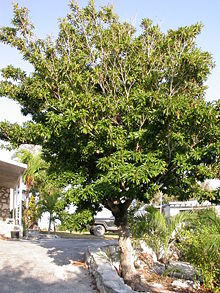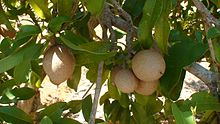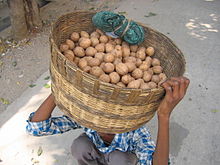- Manilkara zapota
-
Manilkara zapota 
Scientific classification Kingdom: Plantae (unranked): Angiosperms (unranked): Eudicots (unranked): Asterids Order: Ericales Family: Sapotaceae Genus: Manilkara Species: M. zapota Binomial name Manilkara zapota
(L.) P.RoyenSynonyms Achradelpha mammosa O.F.Cook
Achras mammosa L.
Achras zapota L.
Achras zapotilla (Jacq.) Nutt.
Calocarpum mammosum Pierre
Lucuma mammosa C.F.Gaertn.
Manilkara achras Mill. (Fosberg)
Manilkara zapotilla (Jacq.) Gilly
Pouteria mammosa Cronquist
Sapota zapotilla (Jacq.) Coville[1]Manilkara zapota, commonly known as the sapodilla, is a long-lived, evergreen tree native to southern Mexico, Central America and the Caribbean.[1] An example natural occurrence is in coastal Yucatan in the Petenes mangroves ecoregion, where it is a subdominant plant species.[2] It is grown in huge quantities in India, Pakistan and Mexico, and was introduced to the Philippines during Spanish colonisation.
Contents
Description
Sapodilla can grow to more than 30 m (98 ft) tall with an average trunk diameter of 1.5 m (4.9 ft). The average height of cultivated specimens, however, is usually between 9 and 15 m (30 and 49 ft) with a trunk diameter not exceeding 50 cm (20 in).[3] It is wind-resistant and the bark is rich in a white, gummy latex called chicle. The ornamental leaves are medium green and glossy. They are alternate, elliptic to ovate, 7–15 cm long, with an entire margin. The white flowers are inconspicuous and bell-like, with a six-lobed corolla.
The fruit is a large ellipsoid berry, 4–8 cm in diameter, very much resembling a smooth-skinned potato and containing two to five seeds. Inside, its flesh ranges from a pale yellow to an earthy brown color with a grainy texture akin to that of a well-ripened pear. The seeds are black and resemble beans, with a hook at one end that can catch in the throat if swallowed. The fruit has a high latex content and does not ripen until picked, whereupon the fruit softens to a firmness and appearance very similar to that of a fuzzy, brown-skinned kiwifruit.
The fruit has an exceptionally sweet, malty flavor. Many believe the flavor bears a striking resemblance to caramel or a pear candied with brown sugar. The unripe fruit is hard to the touch and contains high amounts of saponin, which has astringent properties similar to tannin, drying out the mouth.
The trees can only survive in warm, typically tropical environments, dying easily if the temperature drops below freezing. From germination, the sapodilla tree will usually take anywhere from five to eight years to bear fruit. The sapodilla trees yield fruit twice a year, though flowering may continue year round.
In Vietnam, the most famous varieties of sapodilla are grown in Xuân Đỉnh village, Hanoi.[citation needed]
Other names
Sapodilla is known as chikoo ("चिक्कू" or chiku, "चीकू,") in India and Pakistan and sapota in some parts of India (Tamil Nadu, Kerala, Karnataka, Andhra Pradesh), sobeda/sofeda (সবেদা or সফেদা) in eastern India and Bangladesh, sabudheli ("ސަބުދެލި") in Maldives, sawo in Indonesia and saos in West of Sumatra or Padang , hồng xiêm (lit. Siamese persimmon), lồng mứt or xa pô chê in Vietnam, lamoot (ละมุด) in Thailand, Laos and Cambodia, sapodilla in Guyana and Trinidad & Tobago, sapathilla or rata-mi in Sri Lanka, zapote in Colombia, El Salvador, Cuba, and the Dominican Republic, níspero in Costa Rica, Cuba, Puerto Rico, Nicaragua, Venezuela and the Dominican Republic, dilly in the Bahamas, naseberry in Jamaica and the rest of the Caribbean, sapoti in Brazil and Haiti, chico or tsiko in the Philippines and chico sapote in Mexico, Hawaii, southern California and southern Florida. [4][5]
In Kelantanese Malay, the fruit is called sawo nilo, which is closer to the original name than the standard Malay ciku. In Chinese, the name is mistakenly translated by many people roughly as "ginseng fruit" (人參果), though this is also the name used for the pepino, an unrelated fruit; it should instead be "heart fruit" (人心果) because it is shaped like the heart.
See also
References
- ^ a b "Manilkara zapota (L.) P. Royen". Germplasm Resources Information Network. United States Department of Agriculture. 1995-11-16. http://www.ars-grin.gov/cgi-bin/npgs/html/taxon.pl?102614. Retrieved 2010-04-30.
- ^ World Wildlife Fund. eds. Mark McGinley, C.Michael Hogan & C. Cleveland. 2010. Petenes mangroves. Encyclopedia of Earth. National Council for Science and the Environment. Washington DC
- ^ Manilkara zapota Sapotaceae (L.) van Royen, Orwa C, Mutua A , Kindt R , Jamnadass R, Simons A. 2009. Agroforestree Database:a tree reference and selection guide version 4.0 (http://www.worldagroforestry.org/af/treedb/)
- ^ "Sapodilla Fruit Facts", California Rare Fruit Growers]. Retrieved on 2009/03/26
- ^ "Ten Tropical Fruits of Potential Value for Crop Diversification in Hawaii", College of Tropical Agriculture and Human Resources. Retrieved on 2009/03/26
- Morton, J. 1987. Sapodilla. p. 393 - 398. In: Fruits of Warm Climates. Julia F. Morton, Miami, FL.
External links
Categories:- Manilkara
- Plants described in 1953
- Tropical fruit
- Trees of Belize
- Trees of Guatemala
- Trees of Jamaica
- Trees of Mexico
- Trees of Nicaragua
- Crops originating from Mexico
- Crops originating from South America
- Vietnamese ingredients
- Crops originating from the Americas
Wikimedia Foundation. 2010.



